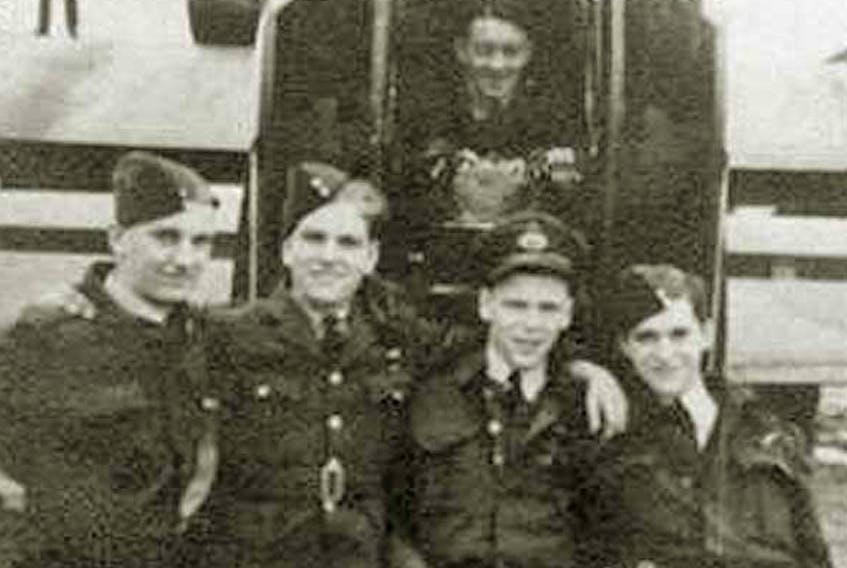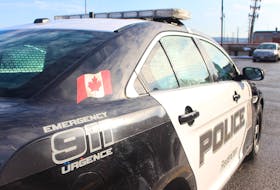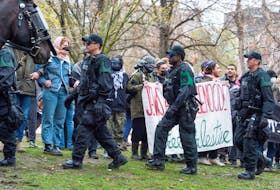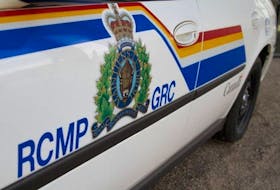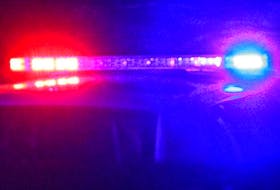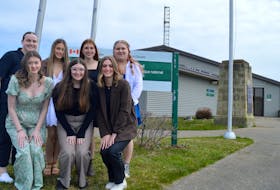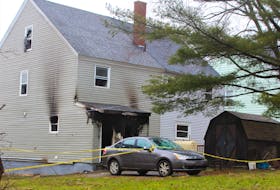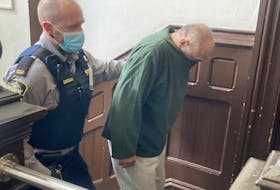SYDNEY, N.S. — It sounds like the climax of a Hollywood blockbuster — parachuting out of a burning plane in the middle of enemy territory during a war — but for former Gabarus Lake resident Murdoch MacKinnon, April 28, 1944, was the day he began his journey back home to Canada from the Second World War.
Enemy fire forced MacKinnon and five other crew members to parachute out of a burning Lancaster bomber that had been on its way to attack Friedrichshafen, Germany. Pilot Flight-Lieut. James A. Watson had ordered his crew to parachute to safety while he remained in control of their plane. Watson subsequently died but the other six crew members made it out alive because of his heroism. All attempted after the war to have Watson honoured for his bravery, recommending the Victoria Cross but Watson received the Mention in Dispatches instead. During the Second World, MID’s were given to a total of 9,666 people, including 2,197 to the Royal Canadian Air Force.
While Watson’s story ended that unfortunate day, other members of the crew went on to lead full, productive lives, including MacKinnon. After the war, he came back home to Canada and ended up settling in the Toronto/Scarborough area where he eventually raised two sons with his wife Jean. MacKinnon died in 2007. One of his sons, Robert James MacKinnon, named after the plane that crashed (the plane was named Robert) and its pilot, interviewed his father in 1991 to get the full story of what happened. MacKinnon’s quotes for the rest of this story are taken from those interview notes. Here is what happened before and after that fateful night.
MODEST ROOTS
“Murdoch’s dad died young,” says Alex MacIntyre, MacKinnon’s cousin, in a phone interview from his Head of St. Margaret’s Bay home.
Murdoch MacKinnon’s mother and her youngest child Alvin went to live with family in the U.S. and left her two older children, MacKinnon and his sister Margaret, in foster care in Sydney. MacIntyre’s grandfather, who was also MacKinnon’s uncle, Alec L. MacIntyre heard MacKinnon wasn’t being well-treated so he went into Sydney to get both children and they all moved into the family farmhouse in Gabarus.
It was a big change for MacKinnon who was around 13 or 14 at the time.
“It was quite a let down when we got out there. There was no electricity. There was oil lamps and there was no central heating or anything like that and there was no radio … And everybody spoke Gaelic.”
While it was different from what he was used to, there was lots to eat, a warm bed and plenty of clothes and MacKinnon soon fit in, remaining at the farm for about 12 years. He then moved to Louisbourg for a while and later started working on ships, first a Norwegian oil tanker and then a tug. He joined the Air Force in Sydney in 1941 and eventually ended up in England for training.
He would take part in 28 successful missions before he was shot down.

HARROWING ORDEAL
A sworn deposition that MacKinnon made after the war in Toronto on March 30, 1946, outlines what happened on that fateful night in 1944.
“We proceeded towards our target in the early morning of April 28th, 1944. While flying towards the target area at a height of approximately 17,000 feet a little to the south of the city of Strasbourg at about 0130 hours, we were suddenly attacked by an enemy night fighter which was driven off, but in the course of a further attack, serious damage was inflicted to our aircraft in my rear turret which was knocked out of commission. About 30 seconds later, we were again attacked by another enemy night fighter which further damaged our aircraft. The starboard wing and the starboard inner engine were set on fire and blazed furiously. The bomber was put out of control but our pilot, the late James Andrew Watson, by extraordinary efforts managed to regain partial control. Efforts were made to extinguish the fire but it was impossible to do so. Flight Lieutenant Watson ordered the members of the crew to abandon the aircraft.
“The aircraft lost altitude rapidly. Nevertheless, Flight Lieutenant Watson remained at the controls and kept the aircraft under sufficient control to enable the other members of the crew and myself to parachute to safety.
"It is beyond doubt that the unselfish conduct of Flight Lieutenant Watson and his devotion to duty and complete disregard for his own safety resulted in the lives of the crew and myself being saved. I sincerely trust that such heroic action be duly acknowledged and strongly urge that Flight Lieutenant Watson be suitably awarded posthumously so commensurate with the highest possible gallantry.”
But while MacKinnon had the highest praise for Watson, his own journey out of the war was also remarkable.
'YOU ALMOST LOST YOUR BOOTS'
A shot to the Lancaster’s tank on the starboard wing had resulted in a fire and MacKinnon knew he had to get out of the plane as soon as possible.
“Everything was blazing like hell,” said MacKinnon. “… You don’t have time to think, you just get out and that’s it. When the chute opened there was a tremendous jerk, you almost lost your boots. The place was down below me in a ball of flames. Just split seconds that’s it.
“Another split second and I wouldn’t be here.”
He landed in a field, ripping off his chute just before an angry dog bounded out of a nearby farmhouse and began chasing him. He took off and ran until he found shelter under some bushes at the edge of a field. He slept there until he heard rifle fire from an old German man on a horse giving commands to a group of kids brandishing sticks.
“He was drilling them. So I just said to myself, 'if they catch me in here they’re gonna shoot me.' They never saw the enemy … I just lay there … for a while. After a while they went away. Then I took off.”

Eventually, he was captured by the Germans. MacKinnon wouldn’t tell them anything beyond his name rank and number. It was there he learned that Watson hadn’t made it.
MacKinnon was sent to a prisoner of war camp in Heidekrug where, true to the legend that Cape Bretoners can be found everywhere, he met some Cape Bretoners.
“I was there about a day when Pinky Gaum and Billy Ayen and Danny Allen came up … and they had pyjamas and toothpaste, a razor, all that stuff. Cigarettes. I didn’t smoke them but they were good for trading. And socks and a pair of shorts, summer was coming on, Christ everything. And they all give it to me and they said, 'you could use this stuff.'”
It was customary for the Cape Bretoners to look after their fellow prisoners, even in the middle of a war. But MacKinnon wouldn’t be there long — he was moved to several other camps and locations. At one point, he even got asked by a German officer to join the German army to fight the Russians but eventually, he made it to Britain and then to Ontario where he would work for the Ministry of Natural Resources and raised his family. As far as his son Robert knows, he never made it back to Cape Breton since he didn’t care for travelling.
After growing up hearing bits and pieces of his father’s war stories, Robert MacKinnon decided to interview his father about what really happened so the memories could be preserved. When doing the interviews, he compiled the work into a booklet and he presented it to his father on Christmas Day.
“He didn’t say anything — all that work and he didn’t say a word,” recalls Robert. “And then he came into the kitchen and said if I had known you were going to take this seriously, I would have told you the whole story.”
Elizabeth Patterson is the culture reporter at The Cape Breton Post.

